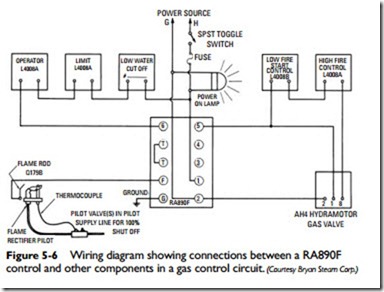Servicing a Gas Burner Primary Control
Access to the wiring terminals of the primary control illustrated in Figure 5-4 is obtained by loosening the screws that secure the chas- sis to the base. When remounting the chassis, be sure to tighten all mounting screws because they also serve as electrical connections.
No attempt should be made to repair a primary control except for tube replacement. Vacuum tubes are used in Honeywell primary controls. Never replace them with radio tubes. If a primary control is defective, the entire chassis should be replaced with a good one.
Operating controls located in the T/T circuit (see Figure 5-6) should be of the low-voltage, two-wire type. A low-voltage trans- former for this purpose is built into a Honeywell Protectorelay.
Safety controls located in 16– terminals must be two-wire, line voltage type. With the exception of the line switch, no controls should ever be placed in the line ahead of the 12– terminals of the primary control.
Before assuming that the primary control is defective, be sure to check the pilot, pilot adjustment, flame detector circuit, and all operating and safety controls; proper operation is also dependent on these external factors. The flame circuit can be more accurately checked by the use of a microammeter to read flame current. Normal operation requires a current of 2 microamperes or more.
Never push relays in manually because it can result in accidental opening of the main diaphragm valve. Be sure to turn off the electrical power before removing the primary control chassis from the base.
Gas Valves
The valves used to control the flow of gas through a gas-fired furnace, boiler, or water heater can be divided into two basic categories: (1) manually operated valves and (2) power-operated valves.
The two manually operated valves (gas cocks) used on gas-fired heating equipment provide a backup safety function in case the automatic gas valves fail to operate. One of these valves is located in either the main gas supply riser or the manifold. The other one is located on the pilot gas line.
The manual gas valve installed on the main gas supply line (riser) or manifold is variously referred to as the main gas shutoff valve, manual shutoff plug cock, or simply the gas cock (see Figure 5-7). This valve provides manual control of the gas flow to the main gas burners. It is not used to control the gas supply to the pilot burner, the latter being provided with its own separate shutoff valves.
The manual valve located on the pilot gas line is called the pilot shutoff cock or the pilot gas cock. It is usually the first controlling device on the pilot line (see Figure 5-7). It provides complete gas shutoff whenever it is necessary to remove and service other controls on the pilot line, such as the pilot gas regulator or the pilot solenoid valve.
Power-operated or automatic valves are actuated by some form of auxiliary power such as hydraulic pressure, pneumatic pressure, electricity, or a combination of these sources. The following are the principal types of power-operated valves used on gas-fired heating equipment:
• Solenoid valves
• Direct-acting heat motor valves
• Diaphragm valves
